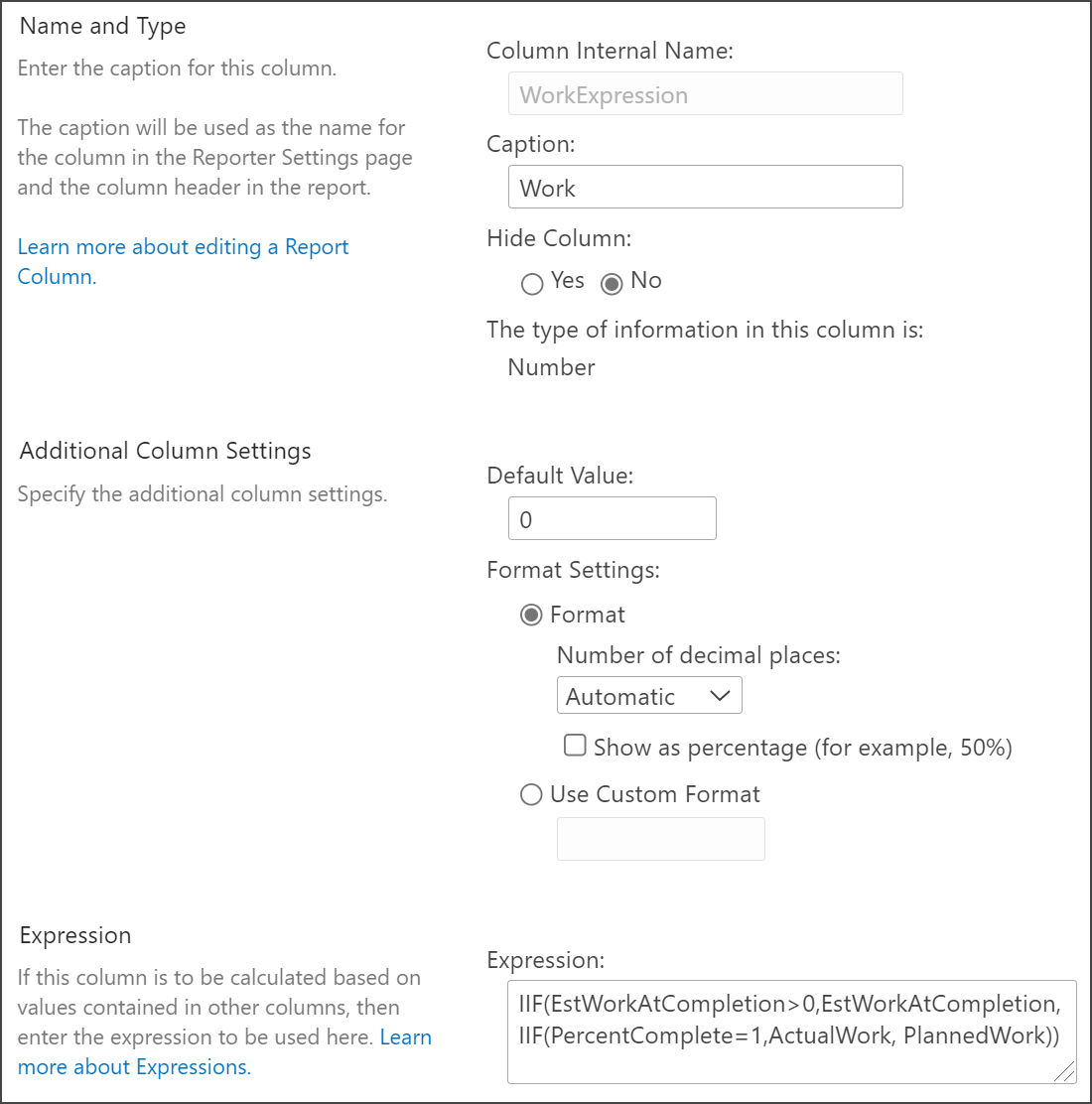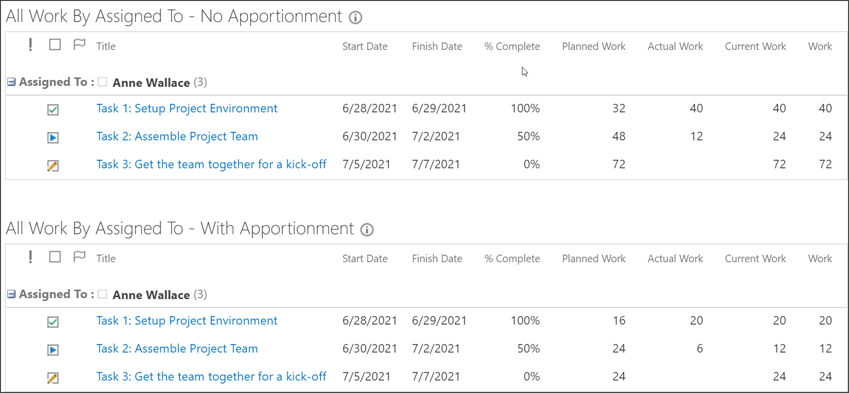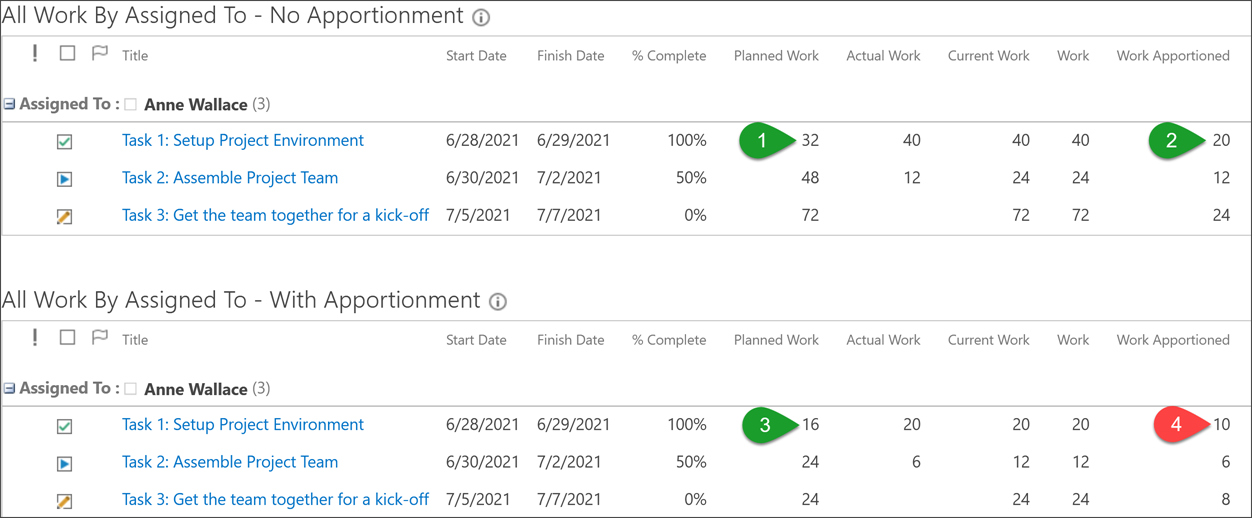Setting Up Apportionment
What is Apportionment?
Apportionment allows you see Work or Costs equally spread between users, if more than one user is assigned to an item.
For example, Task 1 has two people assigned to it and has 32 hours Work to do over two days.

When Reporting on this task, reports will normally show: the Task, the users Assigned To it, and the Work of 32 hours.

However, if you group by the Assigned To column, Work for the Task appears under each person,
with the Work evenly split between them and showing 16 hours each in this case.

Without Apportioning of values, the report would be like this.

The sections below outline how to setup and use Apportionment using a Work Cache or Reporter Definition files for Resource Usage Reports and List Item Reports.
About Apportionment
For Apportioning, the grouping must include one multi-value Person or Group column.
Apportioning works by dividing numeric values like Work or Costs evenly across the individuals assigned to the item. Therefore, for the Apportionment to work in a report, you need the user value (i.e. the Person or Group column) to support multiple values. The list the data comes from, and the report itself, need to support multiple user values. You then group by this multi-value Person or Group column. You can only group by one of these columns, but you can include other groupings.
Updating Assigned To
For the purpose of the examples below, we will assume grouping is by a multi-value Assigned To Column.
BrightWork lists have Assigned To as a single value Person or Group column by default. This would need to be changed to allow multiple values to support apportionment. However, before making that change you need to consider the following possible implications:
- Gantt charts do not support grouping by multi-value Person or Group columns. This applies to both the List Gantt View web part and BrightWork Reporter Gantt reports. So, any existing reports could be impacted.
- Boards do not support swimlanes for multi-value Person or Group columns. So, any existing Board using swimlanes could be impacted.
- Existing Reporter Definition files are configured to assume Person and Group columns have a single value. These would need to be updated to support multi-value Person and Group columns. So, any existing BrightWork Reporter reports could be impacted.
- Work Cache columns are configured to assume Person and Group columns have a single value. These would need to be updated to support multi-value Person and Group columns. So, any existing BrightWork Reporter reports using the Work Cache as its data source could be impacted.
Work Cache Reports
List Item Report
When apportioning values from the Work Cache, all Number and Currency columns selected in Column Settings for a
BrightWork Reporter List Item Report can be apportioned.
However, by default, Assigned To is not configured to allow multiple values. It must allow multiple values in order for apportionment to work.
Please refer to the Updating Assigned To
section to understand the implications of changing an Assigned To column from single value to multi-value.
Resource Report
When selecting a Work Column from the Work Cache, any Number column can be selected, and optionally apportioned.
However, by default, Assigned To is not configured to allow multiple values. It must allow multiple values in order for apportionment to work.
Please refer to the Updating Assigned To
section to understand the implications of changing an Assigned To column from single value to multi-value.
Reporter Definition File Reports
Tip! Use Reporter Definition Files from the BrightWork Reporter Library Data Source when you want to apportion data.
Reporter Definition files can be selected from three sources. The Reporter Library, the Server Gallery, and a Custom Location. We recommend using Reporter Definition files from the Reporter Library as they can be edited using the Report Editor. Reports selected from the Server Gallery cannot be modified and reports in a Custom Location must be modified using a text editor.
List Item Report
List Item Reports can apportion Number and Currency columns with the exception of
Expression Columns.
For example, if you use any out of the box Work report, you will notice that the Cost and Work columns
are not available in the
Apportion Numeric Columns section of the Reporter Settings page.
Expression columns can still be displayed in a report using Apportionment but the results will vary.
Below outlines the scenarios that are possible, using the Work column to illustrate what will happen. First though, here is a description of the Work Expression column in a Reporter Definition file.

The Work Expression has the following rules:
- If the Current Work (i.e. EstWorkAtCompletion) has a value, then Work is set to Current Work (EstWorkAtCompletion).
- If Current Work (EstWorkAtCompletion) does not have a value, then if the % Complete is 100%, the value of Actual Work is used.
- If the % Complete is not 100% then the Planned Work value is used.
The two ways Expression Columns can work in a List Item Report are:
-
Apportion Data for an Expression:
If you apportion the values used to calculate an Expression, the Expression column will then be apportioned in the report.
So, in the current example, if the Current Work, Planned Work, and Actual Work values are apportioned in the report, then the Work column will be apportioned in the report also. This is because the Expression is calculated based on the data displayed in the report.
For example, note the three Tasks Anne Wallace is assigned to in the following screenshot.

Below are two reports. The first report shows Anne Wallace's Work value when the Current Work, Planned Work, and Actual Work are NOT apportioned in the report.
The second report shows Anne Wallace's Work value when the Current Work, Planned Work, and Actual Work ARE apportioned. You can see the difference in the Work columns.

-
Apportion Data in an Expression:
The second approach is to use the an internal column called UserIdCountKey to create a new Number or Currency Expression column. The UserIdCountKey is a reporting feature that is available to use in report Expressions. UserIdCountKey returns the number of people in a Person or Group column that is being used to group by. UserIdCountKey has a default value of '1', so if the Person or Group column is empty, the UserIdCountKey still returns '1'.
In the following example, the formula below can be used to create a new 'Work Apportioned' column. This is done by taking the existing formula for Work and dividing it by the number of users (i.e add/UserIdCountKey).
Tip! Clearly label reporter columns that use the UserIdCountKey so you know where it is has been used.
IIF(EstWorkAtCompletion>0, EstWorkAtCompletion, IIF(PercentComplete=1, ActualWork, PlannedWork))/UserIdCountKeyNote: If you are using UserIdCountKey in an expression AND apportion the values used to calculate the Expression, then you will in effect have double apportioning. This is illustated in the screenshot below.

In the above reports:- The '1' arrow indicates Work values that are NOT apportioned. If you want non-apportioned values then these values are CORRECT.
- The '2' arrow indicates the Work Apportioned value using an Expression with UserIdCountKey in it. This value is CORRECT.
- The '3' arrow indicates Work Apportioned values. If you want apportioned values then these values are CORRECT.
-
The '4' arrow indicates the Work Apportioned value using an Expression with UserIdCountKey in it. This value is INCORRECT.
The reason this is incorrect is because the Work values used in the Expression are apportioned already. Therefore when the 'Work Apportioned' Expression divides by the number of users, it is apportioning the same work a second time, giving the incorrect value.
Resource Report
Number Columns (not an Expression Column):
When a Number column is selected as the Work Column for a Resource Report, you can select the checkbox to
'Apportion Work evenly when grouping by a Person or Group column which allows multiple selections'.

Expression Columns
When an Expression column is selected then:
-
It is NOT possible to apportion Expression columns that do not include the user count value (UserIdCountKey).
For example, the Work column in Work reports is such an expression.

-
Expression columns that DO include the user count value (UserIdCountKey) do the apportionment calculation in the expression.
These columns do not provide the option to de-select the checkbox.

Tip!
To display the number of people assigned to an item in a report, create a Number column with the Expression UserIdCountKey.